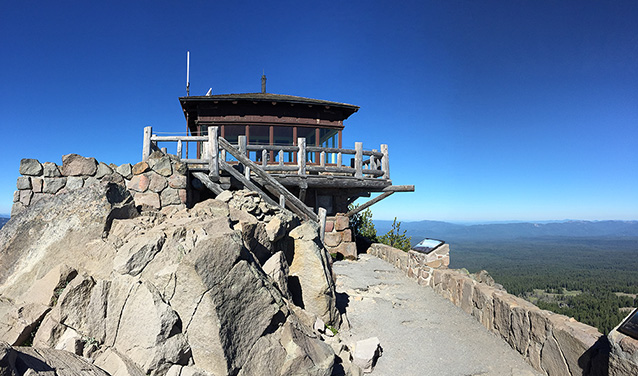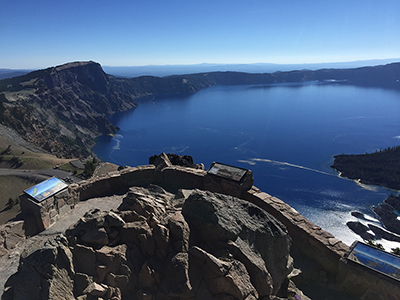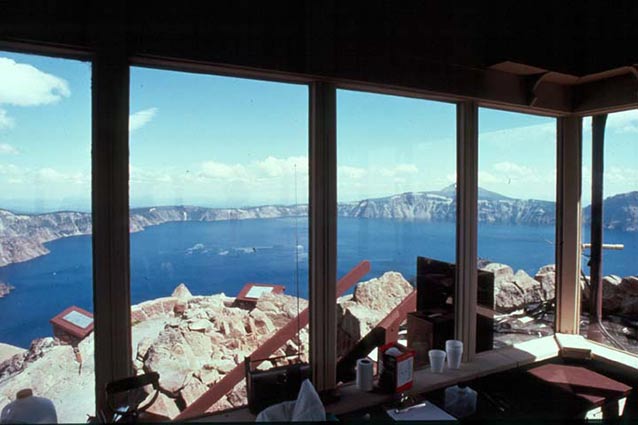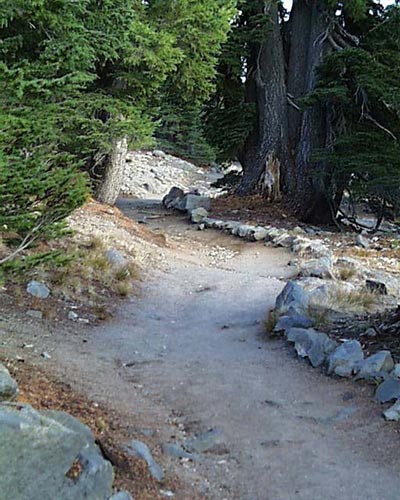The Watchman Observation Station and the Watchman Trail demonstrate architecture and landscape architecture styles commonly employed in park planning and development during the early part of the 1900s. Its particular features were designed for its use as a fire lookout, for visitor enjoyment and interpretation, and to emphasize the surrounding natural views and landscape characteristics.
"It is of little value to run thousands of people up to a scenic point and then hurry them past it to another point. Nature speaks only to one who has ears and time to listen." Worth Ryder, Report on Crater Lake [to John C. Merriam], August 1932, p. 4.

NPS

NPS
The Watchman Observation Station and Watchman Trail are located on the summit of Watchman Peak. A simple trail was aligned in 1916 up Watchman Peak. By the following year, a simple United States Forest Service cupola-styled fire tower was added, for both educational and fire watch purposes. The observation station was designed and constructed as part of the 1920s Crater Lake Master Plan. Organized interpretive and educational activities on Watchman Peak began during the summer of 1926.
The Watchman Observation Station and Watchman Trail are significant for their NPS rustic and naturalistic landscape style of construction. This landscape is also recognized for its association with early park master planning. The trail and structure remain outstanding examples of park engineering and landscape architecture design efforts to blend constructed features seamlessly into their surrounding contexts.

NPS
The Watchman Observation Station was designed by Francis Lange and constructed between 1931 and 1933. The project was made possible by government emergency public works funding, through the Emergency Conservation Work (ECW) and Public Works Administration (PWA).The building incorporated indigenous materials to blend in with its surroundings. Specific aspects of the style included use of native materials, simplicity in design, avoidance of overly perfect construction lines, use of exterior colors such as brown and gray to blend with the setting, and a general look as if the structure was built by pioneer craftsmen. As a fire lookout, the Watchman Observation Station was part of a network of fire lookouts located inside Crater Lake’s boundaries and outside—on U.S. Forest Service lands and elsewhere. As an interpretive site for park visitors, the building housed a museum on the first story and a viewing platform on the second.

NPS
The trail is just under one mile long, providing access for park visitors and rangers from the Watchman overlook parking lot (7600 feet above sea level) to the Watchman Observation Station at the summit (8013 feet above sea level). The trail follows its historic route that begins at the base of Watchman Peak, follows the original alignment of the old Rim Road for approximately 300 yards, then climbs a series of switchbacks up the steep slope of the peak to the observation station at the top.
The width of the historic corridor along the switchback portion of trail is 5 feet from the centerline of the trail in either direction. The trail is moderately steep, a 15 percent grade, and ascends through the sub alpine vegetation zone, which is dominated by Whitebark pines and penstemon.
Today, the Watchman Trail and Watchman Observation Station continue to exemplify the NPS rustic and naturalistic landscape architectural styles of construction. The features also are recognized for their association with early master park planning during the period of significance (1916-1933), when the landscape was planned and established. The Watchman is an outstanding example of park design efforts to blend a trail and structure seamlessly into their surroundings.
Quick Facts
- Cultural Landscape Type: Historic Site
- National Register Significance Level: State
- National Register Significance Criteria: A, C
- Period of Significance: 1916-1933
Landscape Links
Last updated: November 19, 2020
